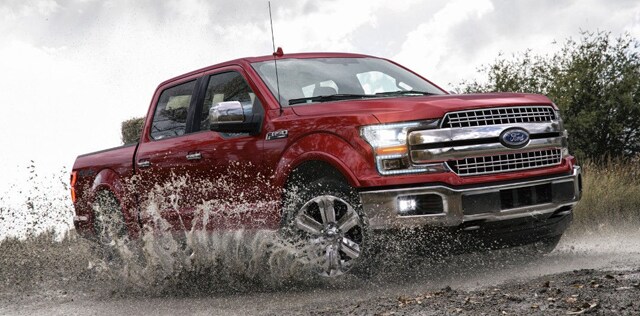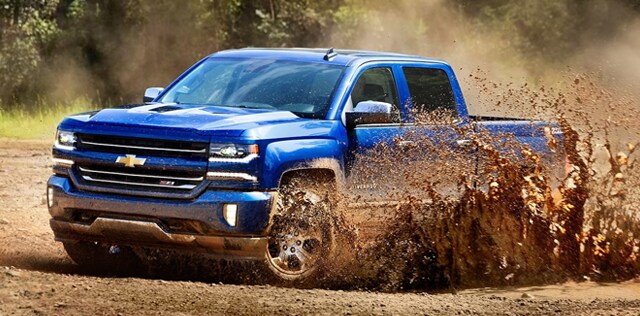
2018 Ford
F-150
Fuel Economy
✔ 19 city/25 hwy
Horsepower
✔ 290 hp

2018 Chevrolet
Silverado 1500
Fuel Economy
✖ 18 city/24 hwy
Horsepower
✖ 285 hp
Having done a total remake only a few years ago, you'd think the 2018 Ford F-150 would simply rest on earlier triumphs. Yet this model has made so many upgrades that Motor Trend has named it 2018 Truck of the Year. How does it stand up to its rival the Chevy Silverado 1500? We'll see in this comparison.
Specs at a Glance
Performance
The Silverado V6 earns 285 horsepower. Ford has revised its V6, edging horsepower up to 290. Where Silverado relies on two V8s, you'll find a Ford V8 and three Ecoboost V6 engines. Silverados either yield 335 horsepower/383 lb.-ft. or 420 horsepower/460 lb.-ft. The Ford HEMI cranks out 395 horsepower and 400 lb.-ft. The first Ecoboost V6 cranks out 325 horsepower/375 lb.-ft. Another Ecoboost V6 cranks out 375 horsepower/470 lb.-ft. of torque. The Raptor generates 450 horsepower and 510 lb.-ft. of torque. With more choices on the Ford, you are more likely to find the exact capability to suit your needs. Ford can claim a number of best-in-class ratings including a top tow limit of 13,200 pounds and a top payload rating of almost 3,200 pounds. The Silverado's top tow rating is 12,500 pounds and top payload rating is 2,250 pounds.
Efficiency
Ford's emphasis on Ecoboost engines allows it to do the work of a V8 while using fuel like a V6. Furthermore, Ford now pairs most of its engines with a slick ten-speed automatic. This gives its engines a better way to control power outlay. The top Silverado automatic is an eight-speed. Last but not least, Ford has dropped significant weight from its trucks by switching to a majority of high-strength aluminum. Chevy still uses steel, which weighs more and is susceptible to rust. Reducing fuel waste at redlights, most Ford F-150s have stop-start technology. Ford engines may also harness their own velocity to maintain speeds, shutting off some cylinders and reducing fuel use. All of these factors help Ford match or beat Chevy in efficiency.
The two trucks have earned a five-star rating from the federal crash testers. Ford has a vibrating steering wheel to add to its warning system while Chevy offers a vibrating seat. Both truck brands have a forward collision warning and a lane departure warning. An autobrake and lane assist add to the effectiveness of these warning systems. Ford's available cruise control system has an autobrake to regulate travel in stop-and-go conditions.
Towing and Parking
Exclusive to the Ford brand, a Dynamic Hitch Assist is built into the rearview camera and helps drivers accomplish hook-ups without damaging the truck. The Pro Trailer Backup Assist can help drivers park their tandem trailer or camper. This exclusive system puts a dial on the dash that acts as a slow-speed steering mechanism. In yet another first, Ford has extended its blind spot monitor to include the trailer. With this system, radar sensors are in the truck's tail lamps, helping the driver remain aware of side traffic issues. Chevy doesn't offer anything like Ford's automated parking system. This will handle most of the maneuvering and make parking much easier in tight spaces. Ford also offers a 360-degree camera system to help drivers deal with tricky slow maneuvers. This is especially useful on crowded worksites where debris, people, and other vehicles are present.
Now that you know more, your next step is a test drive at Camelback Ford. We invite you to discover how the F-150 can serve you.
Question? We Can Help
Make an Inquiry
* Indicates a required field
2025 Ford F-150 STX Truck SuperCrew Cab V-6 cyl
- MSRP1:$55,365
- Ford Offer:$1,250
- Price:$54,115
- Conditional Offer:$1,000
2025 Ford F-150 XL Truck Regular Cab V-8 cyl
- MSRP1:$46,120
- Dealer Discount:$2,500
- Price:$43,620
2025 Ford F-150 STX Truck SuperCrew Cab V-6 cyl
- MSRP1:$55,365
- Ford Offer:$1,250
- Price:$54,115
- Conditional Offer:$1,000
2025 Ford F-150 XL Truck Regular Cab V-8 cyl
- MSRP1:$46,120
- Dealer Discount:$2,500
- Price:$43,620
EPA-estimated city/hwy mpg for the model indicated. See fueleconomy.gov for fuel economy of other engine/transmission combinations. Actual mileage will vary. On plug-in hybrid models and electric models, fuel economy is stated in MPGe. MPGe is the EPA equivalent measure of gasoline fuel efficiency for electric mode operation.


